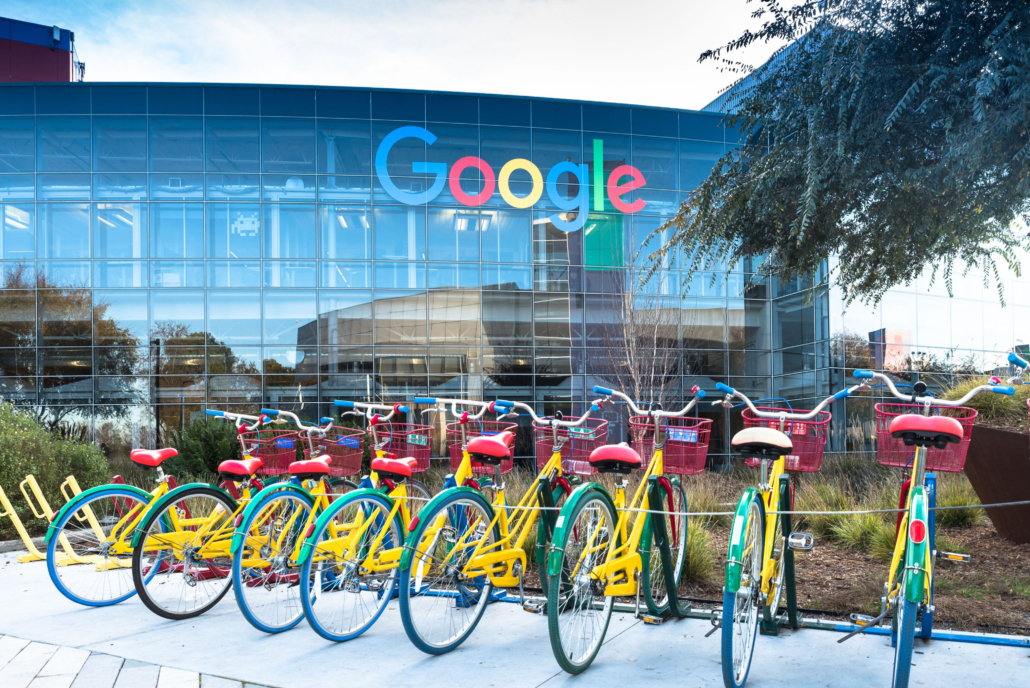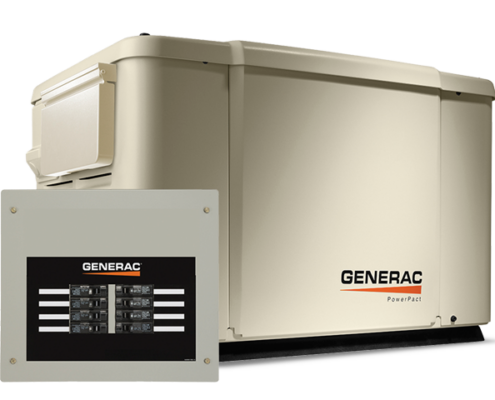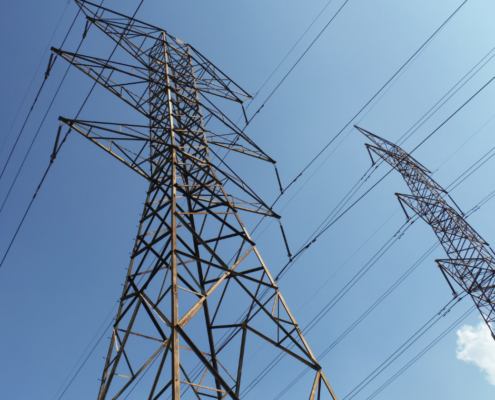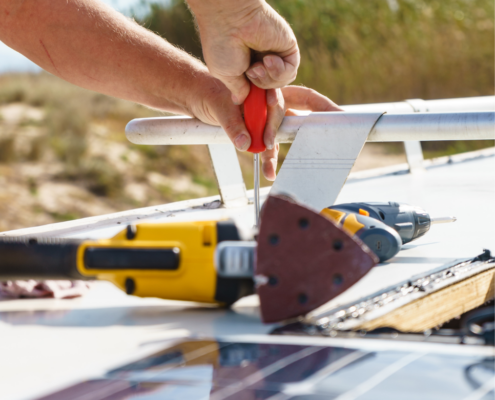Last Updated on August 1, 2022 by Mary Pressler

Google, and Others, Are Going Green
Renewable energy is beneficial not only for the environment and communities, but also for business profits. Corporations have become aware of this, and many are now using renewable sources to cover 100% of their electricity needs.
Each year, the US EPA publishes the Green Power Partnership Fortune 500 Partners List, which ranks corporations based on their green electricity consumption. The latest edition was published in April 22, 2022, and the following companies claimed the top 5 spots:
- Microsoft Corporation
- Google LLC (Alphabet)
- T-Mobile
- Intel Corporation
- The Procter & Gamble Company
Here we will discuss how these five corporations have switched to green electricity, focusing on the technologies and financing options used in each case.
1) Microsoft
Green electricity consumption: 8,324,914,969 kWh
Percentage of total electricity consumption: 100%
Headquarters: Redmond, WA
Microsoft Corporation has been fully powered by renewable electricity since 2014, and their global operations have been 100% carbon neutral since 2012. Microsoft has been named the EPA Green Power Partner of the Year four times in 2012, 2013, 2015 and 2018. The tech giant also won the Leadership Award for Sustained Excellence in Green Power Use in 2020.
Microsoft has reduced its environmental footprint with a combination of green power purchases, energy efficiency measures, and carbon reduction projects. Wind power is Microsoft’s main source of clean electricity, followed by solar power in a distant second place:
| Renewable Source | Microsoft Corporation Consumption (kWh) |
| Wind Power | 6,175,975,285 kWh |
| Solar Power | 1,253,692,684 kWh |
| Low-Impact Hydroelectricity | 284,951,000 kWh |
| Unspecified | 610,296,000 kWh |
| TOTAL | 8,324,914,969 kWh |
Microsoft’s green power supply comes mostly from a combination of financial power purchase agreements (PPA), renewable energy certificates (REC), and electricity tariff options.
- Financial PPAs: 3,606,963,000 kWh
- Renewable Energy Certificates (REC): 3,791,643,000 kWh
- Renewable tariff options: 895,247,000 kWh
- Community choice aggregation (CCA): 30,915,000 kWh
- Self-supply: 146,969 kWh
2) Google
Green electricity consumption: 7,914,747,101 kWh
Percentage of total electricity consumption: 93%
Headquarters: Mountain View, CA
Google is the 2nd largest renewable electricity user, and by 2020 they had purchased more than 55 billion kWh of clean energy. Google signed over 50 PPAs between 2010 and 2020, representing around 6 GW of capacity and $4 billion in purchase commitments through 2034. The company has a very ambitious goal for 2030: operating with carbon-free energy 24 hours per day, 7 days per week, 365 days per year.
Google’s clean electricity consumption is supplied mostly with wind turbines and solar farms, where wind power accounts for the largest share:
| Renewable Source | Google LLC Consumption (kWh) |
| Wind Power | 7,723,091,000 kWh |
| Solar Power | 191,656,101 kWh |
| TOTAL | 7,914,747,101 kWh |
Google’s clean energy supply comes mostly from physical PPAs, onsite generation, and renewable energy purchases from the power grids serving their facilities.
- Physical PPAs: 5,747,902,000 kWh
- Self-supply: 3,394,101 kWh
- Renewable tariff options: 1,525,477,000 kWh
- Utility: 637,974,000 kWh
3) T-Mobile
Green electricity consumption: 7,806,076,868 kWh
Percentage of total electricity consumption: 100%
Headquarters: Bellevue, WA
T-Mobile is a network operator who focuses on 4G LTE and 5G. Between 2021 and 2022, the company increased their share of renewable energy consumption from 24.5% to 100%. T-Mobile’s transition to clean power includes contracts with nine major wind and solar farms, which are providing over 3.4 billion kWh per year. This is equivalent to the electricity consumption of 313,000 US homes.
Wind power represents nearly 50% of T-Mobile’s clean electricity supply, followed by solar power and low-impact hydroelectricity:
| Renewable Source | T-Mobile Consumption (kWh) |
| Wind Power | 3,843,298,214 kWh |
| Solar Power | 1,525,641,005 kWh |
| Low-Impact Hydroelectricity | 1,324,366,205 kWh |
| Unspecified | 1,112,771,444 kWh |
| TOTAL | 7,806,076,868 kWh |
Like most large corporations, T-Mobile has used a combination of power supply options to become 100% renewable:
- Financial PPAs: 2,038,622,000 kWh
- Renewable Energy Certificates (REC): 4,688,230,924 kWh
- Competitive electricity market: 1,009,729,944 kWh
- Renewable tariff options: 69,494,000 kWh
4) Intel
Green electricity consumption: 5,022,773,872 kWh
Percentage of total electricity consumption: 100%
Headquarters: Santa Clara, CA
Intel is the largest chip manufacturer in the world by revenue, providing microprocessors for leading computer brands like Dell and HP. Intel reached 100% green power in 2013, and they currently purchase over 4.9 billion kWh of renewable energy certificates (REC) per year.
- These RECs are validated by third parties, and they come from a combination of sources: wind, solar, geothermal, low-impact hydroelectricity, etc.
- Intel also owns 18 solar farms generating onsite power at their facilities, with a combined capacity of over 20,500 kW.
- In addition, the company is designing all their new facilities according to LEED Silver certification requirements.
At the time of the latest Green Power Partnership Fortune 500 Partners List, Intel had only disclosed a small portion of their renewable energy mix, which consists mostly of wind power. However, all their RECs are certified by third parties.
| Renewable Source | Intel Corporation Consumption (kWh) |
| Wind Power | 295,300,663 kWh |
| Solar Power | 23,000,000 kWh |
| Unspecified | 4,704,473,209 kWh |
| TOTAL | 5,022,773,872 kWh |
RECs account for the largest share of Intel’s green power supply, as mentioned above, but the company also uses other options at a smaller scale.
- Renewable Energy Certificates (REC): 4,704,473,209 kWh
- Utility: 295,297,003 kWh
- Physical PPAs: 23,000,000 kWh
- Others: 3,660 kWh
5) Procter & Gamble
Green electricity consumption: 2,594,266,946 kWh
Percentage of total electricity consumption: 100%
Headquarters: Cincinnati, OH
Founded in 1837, Procter & Gamble is one of the oldest and largest consumer goods corporations in the world. P&G is targeting net-zero emissions by 2040, and they achieved 100% green electricity in 2021. The company is now working to cut emissions from heating and cooling, and they have joined 18 other organizations (manufacturers and governments) to create the Renewable Thermal Collective.
Renewable energy usage at Procter & Gamble is divided as follows, where wind power represents the largest share of their electric supply:
| Renewable Source | Procter & Gamble Consumption (kWh) |
| Wind Power | 2,211,717,892 kWh |
| Solar Power | 1,773,600 kWh |
| Biomass | 361,287,250 kWh |
| Unspecified | 19,488,204 kWh |
| TOTAL | 2,594,266,946 kWh |
Procter & Gamble has achieved 100% clean electricity with a combination of Renewable Energy Certificates and Power Purchase Agreements (PPA):
- Renewable Energy Certificates (REC): 1,948,820,439 kWh
- Physical PPAs: 363,060,850 kWh
- Financial PPAs: 282,385,657 kWh
Conclusion: How Corporations Can Become Greener
Here we have reviewed how the top 5 companies in the Green Power Partnership Fortune 500 Partners List have transitioned to renewable electricity. As you can see in the examples above, companies have access to multiple technologies and supply options. For example, a company can choose between onsite generation with solar panels, or purchasing clean electricity from a remote wind farm through a Power Purchase Agreement (PPA).










Leave a Reply
Want to join the discussion?Feel free to contribute!